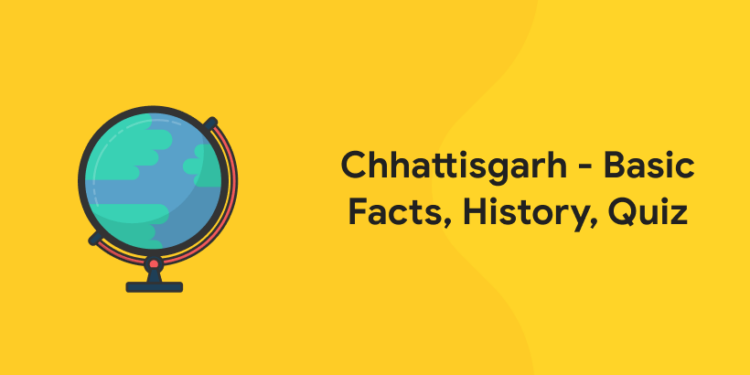Table of Contents
Chhattisgarh is a state in eastern India. It is bordered on the north and northeast by the Indian states of Uttar Pradesh and Jharkhand, on the east by Odisha (Orissa), on the south by Telangana (previously part of Andhra Pradesh), and on the west by Maharashtra and Madhya Pradesh. Raipur is the state capital. 52,199 square kilometres of land (135,194 square km).
The state of Chhattisgarh is situated in the upper Mahanadi River basin, on the Chhattisgarh Plain.The region is known for its knolls, undulating interfluves (areas between neighbouring watercourses), and valleys fronted by clayey soil belts.
Download Entri App and learn various interesting topics
Chhattisgarh: History
Ancient History
Dakshin Kausal was the name given to India’s east-central area in ancient times (or Kosala). Epics such as the Ramayana and Mahabharata reference this woody land.According to mythology, Lord Rama spent some time in the Chhattisgarh region during his 14-year exile to the jungle.Chhattisgarh’s (or south Kosala’s) history dates back to the 4th century.Local monarchs such as Sarabhpurias, Panduavanshi, Somvanshi, Kalachuri, and Nagvanshi ruled the region between the 6th and 12th centuries.From 980 until 1741 CE, the Kalachuris governed Chhattisgarh.
Rajendra Chola I and Kulothunga Chola I of the Chola dynasty attacked the Bastar area of Chhattisgarh in the 11th century.”In the 10th century, a prominent Rajput dynasty ruled at Tripuri near Jabalpur,” writes historian C.W.Wills.By 1000 CE, a scion of the throne named Kalingraja had relocated at Tuman near Bilaspur to create a new kingdom known as the Haihaya dynasty, which occupied a part of central India and was also known as the Kalchuri dynasty.Only a few remnants remain at this location, which is located northeast of the former Laphazamindari in the Bilaspur region.Ratanraja, Kalingraja’s grandson, created Ratanpur, which was the capital of a huge swath of central India that is today known as Chhattisgarh.
The Rajput dynasty’s kings were known as the Haihaya clan. The Haihaya dynasty ruled Chhattisgarh for six centuries, until it was divided into two pieces in the 14th century.One section stayed in Ratanpur, while the other established a semi-autonomous state in Raipur. Raipur and its environs were conquered by the Mughals around the end of the 16th century. The first Chalukya ruler Annmdev established his dynasty in Bastar in the Middle Ages (from 1320). In 1741, the Marathas attacked Chhattisgarh and annihilated the Haihaya power. They dethroned King Raghunathsinghji, the last living member of the Ratanpur line, in 1745 AD after capturing the province.
Modern history of Chhattisgarh
From 1741 until 1845 CE, Chhattisgarh was ruled by the Marathas (Bhonsales of Nagpur). From 1845 until 1947, it was part of the British Empire as the Chhattisgarh division of the central provinces.In the region, which had very few urban settlements at the time, the British prioritised Raipur over the then-capital Ratanpur.For better management, the Sambalpur district was transferred to Odisha, while the Surguja estates from Bengal were created part of Chhattisgarh.
The lands belonging to central provinces were united to form Madhya Pradesh, which is located in the centre part of India, during the reorganisation of states in November 1956.Chhattisgarh was once a part of Madhya Pradesh, which had its capital in Nagpur.Under British administration, the Chhattisgarh region was once part of the central provinces and Berar Province.Under British administration, some sections of the Chhattisgarh region were princely states. However, following Independence, they were amalgamated into Madhya Pradesh.
Chhattisgarh: Basic Facts
1: Who was the first woman President of India?
- Dakshin-Kausal was Chhattisgarh’s ancient name.
- From 980 until 1741 AD, the Kalachuris were the most powerful rulers in this region. In the 11th century, the Chola dynasty attacked and ruled a portion of this territory.
- During pre-modern times, the Marathas ruled over this territory (Bhonsale clan of Nagpur). From 1845 to 1947, it was under British authority.
- Uttar Pradesh is bordered on the north by Jharkhand on the northeast, Odisha on the east, Andhra Pradesh on the south, Telangana on the southwest, Maharashtra on the west, and Madhya Pradesh on the northwest.
- With an elevation of 1,276 metres, the Bailadila range in Dantewada district is the state’s highest mountain.
- The Chitrkot Waterfalls are in the Bastar district, near Jagdalpur. Indravati is the name of the river that runs through it. It is also known as the Niagra Falls of India because of its wide spread during the monsoon season.
- The state’s central region is located in the fertile Mahanadi range, which produces a lot of rice.
- Pola, Nawakhai, Dussehra, Diwali, Holi, and Gowardhan puja are the state’s major festivals.
- Chhattisgarh is one of the states having the biggest population of Schedule Tribes. Together, the SC and ST make up half of the population of the state.
- This state’s literacy rate is 71.04 percent, which is lower than the national average of 74.04 percent. In terms of literacy, CG is ranked 20th among Indian states.
- Pandwani is a song and music-based retelling of Mahabharat events. Teejan Bai is a well-known Pandwani folk singer. In the states of Chhattisgarh and Madhya Pradesh, this song form is well-known.
- It is the country’s poorest region, yet it is rich in minerals and generates income from mining. The state’s mineral resources are the mainstay of the economy.
Attempt free GK Mock Test! Download Entri App!
Free UPSKILLING Courses!
Take your first step toward mastering in-demand skills, acing interviews, and securing top-tier jobs with Entri's free upskilling courses.
Start Learning!Chhattisgarh: Quiz
Q.1.What is the official language of the state of Chhattisgarh?
(a) Marathi
(b) Hindi
(c) English
(d) None of these
Ans: Hindi
Q.2.In Chhattisgarh, how many districts are there?
(a) 62
(b) 35
(c) 27
(d) None of These
Ans: 27
Q.3.What is the state animal of Chhattisgarh?
(a) Butterfly fish
(b) Indian palm squirrel
(c) Indian grey mongoose
(d) Wild buffalo
Ans: Wild buffalo
Q.4.What is the state flower of Chhattisgarh?
(a) Cannonball
(b) Strobilanthes kunthiana
(c) Alfalfa
(d) Rhynchostylis gigantea
Ans: Rhynchostylis gigantea
Q.5.The Aondhi Dam was built on which river?
(a) Tapti
(b) Bande Nadi
(c) Mahanadi River
(d) None of These
Ans: Bande Nadi
Q.6.Who was Chhattisgarh’s first Chief Minister?
(a) Ajit Jogi
(b) Raman Singh
(c) Harekrushna Mahatab
(d) None of These
Ans: Ajit Jogi
Q.7.When did the state of Chhattisgarh come into being?
(a) Sep 2010
(b) Oct 2005
(c) NOv 2000
(d) None of These
Ans: 01 November 2000
Q.8.What is the name of Chhattisgarh’s capital?
(a) Shimla
(b) Raipur
(c) Ranchi
(d) Bhubaneswar
Ans: Raipur
Q.9.Which state borders Chhattisgarh to the east?
(a) Punjab
(b) J&K
(c) Goa
(d) None of these
Ans: Odisha
Q.10.What does the name Chhattisgarh imply?
(a) Land of King
(b) Great Nation
(c) 36 forts
(d) None of these
Ans: 36 forts













